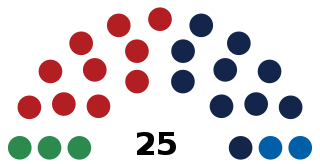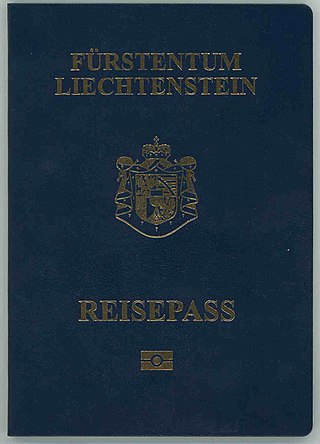See also
| Sovereign states |
|
|---|---|
| States with limited recognition | |
| Dependencies and other entities | |
| | This Liechtenstein-related article is a stub. You can help Wikipedia by expanding it. |
Fauna of Liechtenstein may refer to:

Liechtenstein, officially the Principality of Liechtenstein, is a doubly landlocked German-speaking microstate located in the Alps between Austria and Switzerland. Liechtenstein is a semi-constitutional monarchy headed by the prince of Liechtenstein of the House of Liechtenstein, currently led by Hans-Adam II. Liechtenstein is bordered by Switzerland to the west and south and Austria to the east and north. It is Europe's fourth-smallest country, with an area of just over 160 square kilometres and a population of 39,790. It is the world's smallest country to border two countries.

The economy of Liechtenstein is based on industry, with a small but significant agricultural sector, and services. The country participates in a customs union with Switzerland and uses the Swiss franc as its national currency. It imports more than 85% of its energy requirements. Liechtenstein has been a member of the European Free Trade Association (EFTA) since 1991. It also has been a member of the European Economic Area (EEA) since May 1995 and participates in the Schengen Agreement for passport-free intra-European travel.

Liechtenstein's foreign economic policy has been dominated by its customs union with Switzerland. This union also led to its independent membership in the European Free Trade Association (EFTA) in 1991. Unlike Switzerland however, Liechtenstein is part of the European Economic Area.

Political identity came to the territory now occupied by the Principality of Liechtenstein in 814, with the formation of the subcountry of Lower Rhætia. Liechtenstein's borders have remained unchanged since 1434, when the Rhine established the border between the Holy Roman Empire and the Swiss cantons.

Vaduz is the capital of Liechtenstein and also the seat of the national parliament. The city, which is located along the Rhine, has 5,696 residents. The most prominent landmark of Vaduz is Vaduz Castle, perched atop a steep hill overlooking the city. It is home to the reigning prince of Liechtenstein and the Liechtenstein princely family. The city's distinctive architecture is also displayed in landmarks such as the Cathedral of St. Florin, Government House, City Hall, the National Art Gallery, as well as the National Museum. Although Vaduz is the best-known town in the principality internationally, it is not the largest; neighbouring Schaan has a larger population.

Hans-Adam II is the Prince of Liechtenstein. He is the son of Prince Franz Joseph II and his wife, Countess Georgina von Wilczek. He also bears the titles Duke of Troppau and Jägerndorf, and Count of Rietberg. Under his reign, a 2003 constitutional referendum expanded the powers of the Prince of Liechtenstein. In 2004, Hans-Adam transferred day-to-day governmental duties to his eldest son Hereditary Prince Alois as regent, like his father had granted him in 1984 to prepare him for the role.

The Liechtenstein national football team is the national football team of the Principality of Liechtenstein and is controlled by the Liechtenstein Football Association. The organisation is known as the Liechtensteiner Fussballverband in German. The team's first match was an unofficial match against Malta in Seoul, a 1–1 draw in 1981. Their first official match came two years later, a 0–1 defeat from Switzerland. Liechtenstein's largest win, a 4–0 win over Luxembourg in a 2006 FIFA World Cup qualifier on 13 October 2004, was both its first ever away win and its first win in any FIFA World Cup qualifier. Conversely, Liechtenstein is the only country that lost an official match against San Marino, albeit in a friendly match. Liechtenstein suffered its biggest ever loss in 1996, during qualification for the 1998 FIFA World Cup, losing 1–11 to Macedonia, the result also being Macedonia's largest ever win to date. The team's head coach is currently Konrad Fünfstück.

Rheinpark Stadion in Vaduz is the national stadium of Liechtenstein. It plays host to home matches of the Liechtenstein national football team, and is also the home of football club FC Vaduz. It lies on the banks of the river Rhine, just metres from the border with Switzerland.
The Liechtenstein Football Cup is Liechtenstein's premier football competition, and has been organised annually by the Liechtenstein Football Association (LFV) since 1946. The winner qualifies to take part in the UEFA Conference League.

The House of Liechtenstein, from which the principality takes its name, is the family which reigns by hereditary right over the principality of Liechtenstein. Only dynastic members of the family are eligible to inherit the throne. The dynasty's membership, rights and responsibilities are defined by a law of the family, which is enforced by the reigning prince and may be altered by vote among the family's dynasts, but which may not be altered by the Government or Parliament of Liechtenstein.

The Landtag of the Principality of Liechtenstein, commonly referred to as the Landtag of Liechtenstein, is the unicameral parliament of Liechtenstein.
ISO 3166-2:LI is the entry for Liechtenstein in ISO 3166-2, part of the ISO 3166 standard published by the International Organization for Standardization (ISO), which defines codes for the names of the principal subdivisions of all countries coded in ISO 3166-1.

Liechtenstein passports are issued to nationals of Liechtenstein for the purpose of international travel. Beside serving as proof of Liechtenstein citizenship, they facilitate the process of securing assistance from Liechtenstein consular officials abroad.

Liechtenstein first participated in the Olympic Games in 1936, and has sent athletes to compete in most Summer Olympic Games and Winter Olympic Games since then. The Liechtenstein Olympic Committee was created in 1935.

The following outline is provided as an overview of and topical guide to Liechtenstein:

Alois, Hereditary Prince and Regent of Liechtenstein, Count of Rietberg, is the eldest son of Hans-Adam II, Prince of Liechtenstein, and Countess Marie Kinsky von Wchinitz und Tettau. The heir apparent to the throne of Liechtenstein, Alois has also been regent of the country since 15 August 2004. He is married to Duchess Sophie in Bavaria, who is a member of the House of Wittelsbach, and second in line for the Jacobite succession.

The monarchy of Liechtenstein is the constitutional form of government by which a hereditary sovereign reigns as the head of state of Liechtenstein. The current monarch is Prince Hans-Adam II. The House of Liechtenstein, after which the sovereign principality was named in 1719, hails from Liechtenstein Castle in Lower Austria, which the family possessed from the middle of the twelfth century to the thirteenth century, and from 1807 onward. It is the only remaining European monarchy that practises strict agnatic primogeniture.